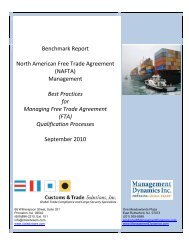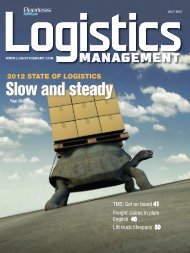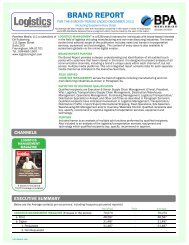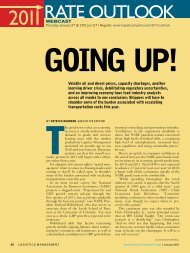Logistics Management - October 2011
Logistics Management - October 2011
Logistics Management - October 2011
Create successful ePaper yourself
Turn your PDF publications into a flip-book with our unique Google optimized e-Paper software.
year in August. Now, August 2010wasn’t a banner month, but it wasn’tterrible either. There’s a lot of freightlooking for capacity and a lot of capacitylooking for freight.”According to Montague, one thing is forcertain: There’s pressure for rates to rise.There are several reasons. One isthat so much capacity—as much as 20percent—came out of the truckloadmarket during the 2008-09 recessionthat truckers have been slow to re-enterthe market. On top of that, truck equipmentcosts are growing by double-digitpercentages. Even though Class 8 trucksales are booming, analysts say that’snearly all replacement vehicles to makeup for the lack of fleet capitalizationthat occurred during the recession.“There are a lot of factors impedingcapacity in the short term,” MontagueregulationCourt puts the brakes on Feds’push for “black boxes”WASHINTON, D.C.—In a major victoryfor independent truck drivers fearing“big brother” harassment, the governmenthas been forced into the legalslow lane in its attempt to crack downon unsafe truckers.The Federal government’s attemptto mandate electronic onboard recorders(EOBRs)—the so-called “blackboxes” that record everything fromspeed to braking attempts during crashincidents—has run into a serious legalroadblock.In a major blow to its truck safetyreform program, the 7th Circuit U.S.Court of Appeals has told the FederalMotor Carrier Safety Administration(FMCSA) to go back to the legal drawingboard on this ruling. Experts say therule could be delayed as long as twoyears, perhaps longer.That’s because the court appeared tohint that the overall EOBR rulemakingprocess violated the 4th Amendment ofthe U.S. Constitution that forbids illegalsearches and seizures.“We conclude that the rule cannotstand because the Agency failedsaid. “It’s like what you see in the airlines.They used to flood the skies withcapacity, but not anymore. So far truckingfleets seem to be very disciplined inadding trucks.”Flatbed trucks are a good example.One thing unusual this year is flatbedcapacity has been in tight supply.“There’s not sufficient supply to meetdemand,” Montague added, so flatbedrates have continued to rise the entireyear. “That equipment is in strongdemand.”Refrigerated transport seems to befollowing suit. Reefer rates seemed tohave a “second peak” during the thirdquarter. Again, that was because oftight equipment supplies, lack of drivers,and increasing demand even in thisso-so economic environment. M—John D. Schulz, Contributing Editorto consider an issue that it was statutorilyrequired to address,” the courtsaid in its ruling in late August. Specifically,the court ruled that FMCSAdid not take adequate steps in theregulatory process to assure that theblack boxes “are not used to harassvehicle operators.”That was a major legal victory for theOwner-Operator Independent DriversAssociation (OOIDA). OOIDAhad sued the government on groundsthat EOBRs could be used to pressuredrivers to drive when tired. The courtagreed.For shippers, the ruling meansanother layer of uncertainty in theregulatory process regarding the truckingcompanies they utilize. Already,the government is mulling whether toreduce the legal hours of service truckerscan operate by one hour. That rulingis expected late this year or early 2012.EOBRs, which cost about $800 onthe low end and can run as much as$3,000 depending on the amount ofadd-on electronic capabilities, werea central tenet of the government’sattempt to crack down on unsafe operators.They’re attached internally tocommercial vehicles and automaticallyrecord the number of hours a driverspends operating a vehicle.At the outset, they were being mandatedin trucks operated by about 5,700carriers that have been deemed to havesignificant HOS violations. That rulingwas to have gone into effect in mid-2012, but now is delayed indefinitely.Ultimately, trucking officials expectedEOBRs to be mandated on all newtrucks later in the decade, but thatprospect is now anything but clear.The court’s ruling was worded sostrongly against the government, truckingexperts say, that any attempt tomandate EOBRs on all 700,000 truckersregistered at the Department ofTransportation will need to be carefullycrafted to ensure privacy rights for individualtruck drivers.“The agency needs to consider whattypes of harassment already exist, howfrequently and to what extent harassmenthappens, and how an electronicdevice capable of contemporaneoustransmission of information to a motorcarrier will guard against (or fail toUltimately, trucking officials expected EOBRs to be mandatedon all new trucks later in the decade, but that prospect is nowanything but clear.guard against) harassment,” a threejudgepanel in the 7th Circuit said inits ruling.That is almost precisely what OOIDAhad argued. “Companies can and do usetechnology to harass drivers by interruptingrest periods,” said OOIDA ExecutiveVice President Todd Spencer after theruling. He added that the court’s decisionfocused on harassment issues but<strong>October</strong> <strong>2011</strong> | WWW.LOGISTICSMGMT.COM <strong>Logistics</strong> <strong>Management</strong> 15
















